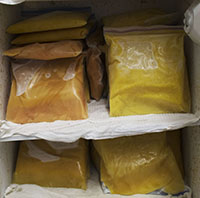 Any conversation about calf care should include the vital role colostrum plays in setting a calf up for a healthy life. The immunity boost a calf receives while its own immune system is developing can help fight off diseases in calfhood and beyond.
Any conversation about calf care should include the vital role colostrum plays in setting a calf up for a healthy life. The immunity boost a calf receives while its own immune system is developing can help fight off diseases in calfhood and beyond. Some farms make it a priority to feed each calf fresh colostrum from its own dam whenever possible. While that's an admirable goal, is fresh colostrum superior to refrigerated or frozen colostrum previously collected from another cow?
To answer that question, researchers from the University of Florida and Texas A&M studied a group of 182 Holstein calves from a Florida dairy. All calves were fed 3.8 L (one gallon) of colostrum with an esophageal tube feeder. A colostrometer was used to measure immunoglobulin concentration, and all colostrum fed tested above 90 mg/mL.
The calves were split into three groups, receiving either fresh colostrum collected from the dam, frozen colostrum or refrigerated colostrum. Statistical analysis showed that the quality of the colostrum was not significantly different between the three groups.
The calves were evaluated for performance, health and survival from birth to weaning. Average daily gain for all three groups was 1.23 ± 0.35 pounds per day. In terms of health, half of the calves received at least one treatment for a health-related problem in the first 60 days of life. The mortality rate for this group of calves was 4.4 percent.
In the study, average daily gain did not appear to be impacted by the colostrum source. No association was found between source of colostrum and number of treatments or number of days on treatment, either. In addition, calf mortality rate was also not correlated with colostrum source.
From this data, it appears that refrigerated or frozen colostrum can be just as effective as fresh colostrum straight from the dam. And, if having high-quality colostrum stored and ready to use allows feeding to happen sooner, it may be even more effective. Of course, whatever the source, quality must be measured, and colostrum must be properly stored, to be sure that a calf's first meal is the best it can be.

The author is an associate editor and covers animal health, dairy housing and equipment, and nutrient management. She grew up on a dairy farm near Plymouth, Wis., and previously served as a University of Wisconsin agricultural extension agent. She received a master's degree from North Carolina State University and a bachelor's from University of Wisconsin-Madison.








